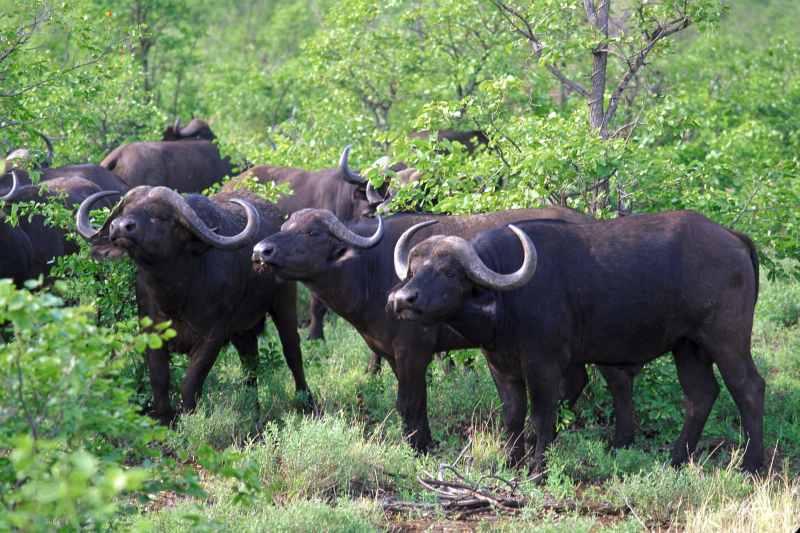
The Mole National Park is a fairly undisturbed Guinea Savannah ecosystem with limited human impact through annual bush burning, localized farming and collection of fuel wood and wild fruits. The vegetation type is the Guinea Savannah, a dominantly woodland, with a grass layer that reaches up to three meters during the rainy season.
There are also noticeably narrow bands of gallery forests along many streams. All these environmental conditions make the area most suited to biodiversity conservation and justify the continued existence of the over 742 plant and fauna species of the Park, which are well spread throughout the savannah zone.
Detailed descriptions of the zoological records have been provided in Aerial and ground zoological surveys, which have indicated that substantial numbers of various faunal species were available at the Park. Eight larger species of mammals, including elephant, buffalo, roan, hartebeests, water buck, kob, oribi and baboons, duikers, monkeys, and many bird species including francolins, swallows, sparrows, egrets and guinea fowls. Estimates for various species include the Oribi (5,000), elephants (500), buffalo (3,000) hartebeest (4,000-5,000), waterbuck (4,000), kob (4,000) and roan antelope (1,958). Substantial numbers of smaller mammals like the baboon, the red-flanked duiker and species of antelopes are very common.
A small population of over ten hippopotamus, residing in the River Kulpwan, is being protected by the people of adjacent villages as gods. The main animal species at the Park include elephants, roans antelopes, hartebeest, buffalo, waterbuck, and kob herds. There are also large carnivores such as leopard, lion and hyena. These carnivores and their herbaceous neighbours constitute a major tourist attraction. The most interesting thing in the park is the ease with which visitors can freely see these animals except for the lions and leopard that are active at late night. For all tour, well trained and armed tour guide(s) go with visitors to ensure their absolute safety and security.
However, for visitors who would not like to go on nature tours, there is a higher wooding platform closer to the reception area that enables visitors to see the animals without necessarily getting closer. This is mostly enjoyed by visitors with binoculars.
About 20 elephants could be spotted taking their bath in the pond which is just 200 meters way from the reception area. Also within the park is a restaurant where visitors could have access to both local and continental food. You can also relax in a pool after a long safari tour. For those who wish to have overnight stays, the motel in the park provides a range of rooms dormitory, double room to en-suite chalets with air conditioners.
For those interested in camping, Mole National Park is the place to be since it is possible to camp near the motel or other alternative sites in the park. Campers are however advised to take care of their properties since warthogs and baboons sneak to steal properties form visitors especially food items. There is a souvenir shop close by for you to buy some Ghanaian craft or anything needed .You may also have the pleasure to see “Onipa Nua”; the elephant which may allow you to pose with him for a picture. Visitors are cautioned to abstain from feeding animals at the park. Other nearby attractions are the Larabanga Mosque, Bui National Park and Larabanga Mystic stone.
The Park is located in the West Gonja District Assembly area of the Northern Region of Ghana and lies between Latitude 9° 12’ and 10° 6’ North and to Longitudes 1° 25’ and 2° 17’ West. The Park is about 146 kilometers or two hour’s drive from Tamale, the regional capital, and 15 kilometers from Damongo the district headquarters of West Gonja District Assembly.
In terms of size, it is the largest national park in the country, found on a savannah woodland ecosystem. The Park is the largest of the seven declared national parks in Ghana. It is also one of the three parks established in the interior Savannah ecological zone in the north of the country. Mole National Park is by far the most prestigious in terms of visitor attraction and tourist facilities, both in quantity and quality. The park is under the control of the Ghana Wildlife Division of the Forestry Commission.
Entrance Fees
Entry fee for foreign adults is 10 Ghana cedis and that of foreign students is 5 Ghana cedis. However, foreigners who will claim to students must authenticate that with an ID. Hourly charge of 3 Ghana cedis is then paid for tours by both foreigner and locals. 100 Ghana cedis is also paid for hiring vehicle for safari tours. In any case, if you have your own 4×4 vehicle, you can drive yourself but with an armed ranger. Separate amounts are charged at the entrance for cars, taxis, vans and buses.
How To Get There
Travelling to Mole is cool. The distance is about 658 km north of the capital, Accra and about 100 km from Techiman. One can easily reach this place as it is connected by good road network. From the capital Accra, you can either go by air with an inter-city link fight to Tamale (Capital) and board a trotro or rent and taxi to the park. Cost of intra-flight to Tamale range between Gh¢ 100 and Gh¢ 200. You can also choose to go by a rented car, trotro (relatively cheaper than rented cars), STC, from Accra through Kumasi to Tamale. You can also get a trotro car from Bole to Sawla and to Damago mostly in the mornings. From Damango which is closest town you can get a car to Tamale of Kumasi and connect to Accra either by STC, OA, VIP or even trotro. The trotro system is very common among all the Ghanaian transport systems.
By Sheila Williams


























